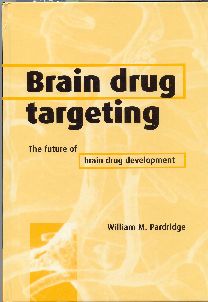Review: Brain drug targeting: The future of brain drug development
William A. Pardridge
Cambridge University Press, Inc., 2001, 353 pages
Reviewed by: 

 Although some could argue that it places excessive
emphasis on the author's own studies, Brain Drug Targeting brings
a healthy skepticism to the study of the blood-brain barrier (BBB), which is the
most frustrating obstacle for pharmacologists wishing to find treatments
for brain disorders. Well-organized, up to date, and expertly written
by an well-known researcher in the field who has worked and written
books on the blood-brain barrier for many years, the emphasis of
this book is on pharmacological and physiological aspects of
the BBB; relatively little is known at the biochemical level
about signal transduction pathways and protein phosphorylation
specific to the blood-brain barrier, and these topics are clearly
outside the author's area of expertise.
Although some could argue that it places excessive
emphasis on the author's own studies, Brain Drug Targeting brings
a healthy skepticism to the study of the blood-brain barrier (BBB), which is the
most frustrating obstacle for pharmacologists wishing to find treatments
for brain disorders. Well-organized, up to date, and expertly written
by an well-known researcher in the field who has worked and written
books on the blood-brain barrier for many years, the emphasis of
this book is on pharmacological and physiological aspects of
the BBB; relatively little is known at the biochemical level
about signal transduction pathways and protein phosphorylation
specific to the blood-brain barrier, and these topics are clearly
outside the author's area of expertise.
The use of liposomes and nanoparticles to transport drugs across the BBB has a particularly checkered history, with some studies having coinjected Polysorbate 80, a detergent that can disrupt the BBB, with the drug as a stabilizing agent, and incorrectly attributing the detergent effects to their own nanoparticles. In other studies, the large size of the liposomes that were used produced microembolisms that gave a false impression of brain uptake.
The study by Huwyler in the author's lab, in which OX26-MAb conjugated pegylated immunoliposomes were injected in attempts to transport daunomycin through the BBB, illustrates the difficulty researchers have experienced with this approach. Almost all the rhodamine label from rhodamine-conjugated phosphatidyl ethanolamine was found to be localized to capillary endothelial cells. The author's paper, discussed in the book, that demonstrated endocytosis of immunoliposomes into cultured RG2 glioma cells was an important milestone. However, the problem of getting agents across the BBB and into the brain parenchyma still remains.
Other chapters discuss receptor-mediated transcytosis of peptides, chimeric peptides, and linker strategies such as avidin-biotin conjugates, pegylation technology, and antisense neurotherapeutics, using data from the author's laboratory to illustrate typical results.
